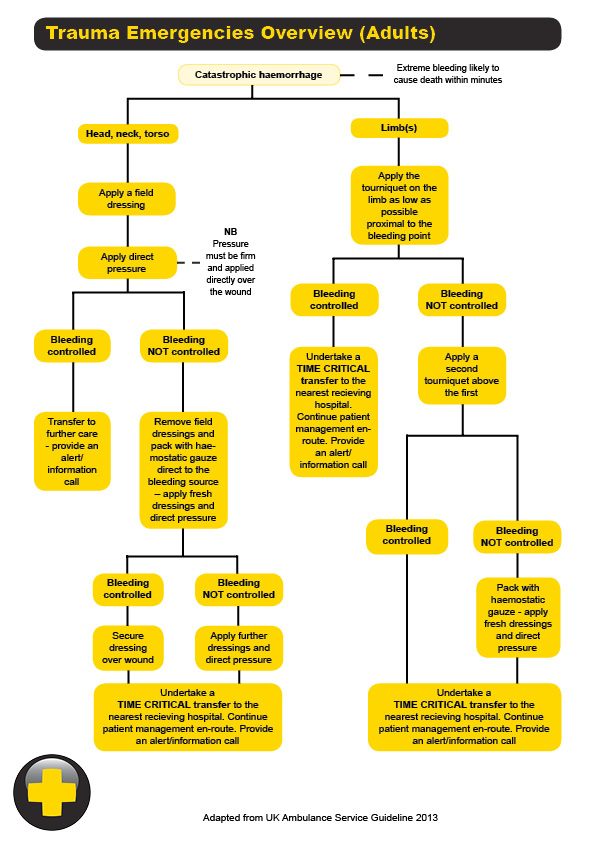New protocol for catastrophic bleeding
This flow chart summarises the treatment of catastrophic bleeding.
It is reproduced from the UK Ambulance Services Clinical Practice Guidelines 2013 (JRCALCs). This is the new protocol for catastrophic bleeding in adults and there is a similar flow chart for children.
In the diagram there are specific guidelines on when it is appropriate to use haemostatic gauzes such as Celox Rapid.
The Clinical Practice Guidelines are a vital resource for ambulance clinicians. The Association of Ambulance Chief Executives, the Joint Royal Colleges Ambulance Liaison Committee and the National Ambulance Service Medical Directors welcome the publication of the latest 2016 edition, which comprises of 128 guidelines.
You can find the 2013 JRCALCs by clicking here.
Contents:
Cardiac Emergencies
- Adult Basic Life Support (BLS)
- Adult advanced life support (ALS)
- Acute coronary syndrome
- Adult foreign body airway obstruction
- Cardiac rhythm disturbance
- Bradycardia algorithm
- Implantable cardioverter defibrillators (ICD)
- Recognition of life extinct for ambulance clinician (ROLE)
- Traumatic cardiac arrest
- 12-lead ECG
Emergencies in Children
- Anaphylaxis and allergic reactions in children
- Asthma in children
- Child advanced life support (ALS)
- Child basic life support (BLS)
- Child Foreign Body Airway Obstruction
- Glasgow Coma Scale (Modified)
- Newborn life support
Obstetric and Gynaecological Emergencies
- Delivery Flowchart
- Maternal Assessment
Emergencies in Adults
- Anaphylaxis and allergic reactions in adults
- Asthma in adults
- Cervical spine immobilisation
- CBRN – SORT
- CBRN – Adult Triage Sieve
- Chronic obstructive pulmonary disease (COPD)
- Peak expiratory flow rate
- Suicide and Self Harm Risk Assessment
Major Incidents
- ADR Codes
- HAZCHEM codes
- Major Incident METHANE report
Drugs
- Age specific charts for resuscitation and other emergencies in children
- Drug Protocols
- Oxygen therapy and ventilation
Pain Management
- Pain Management in Adult and Children



